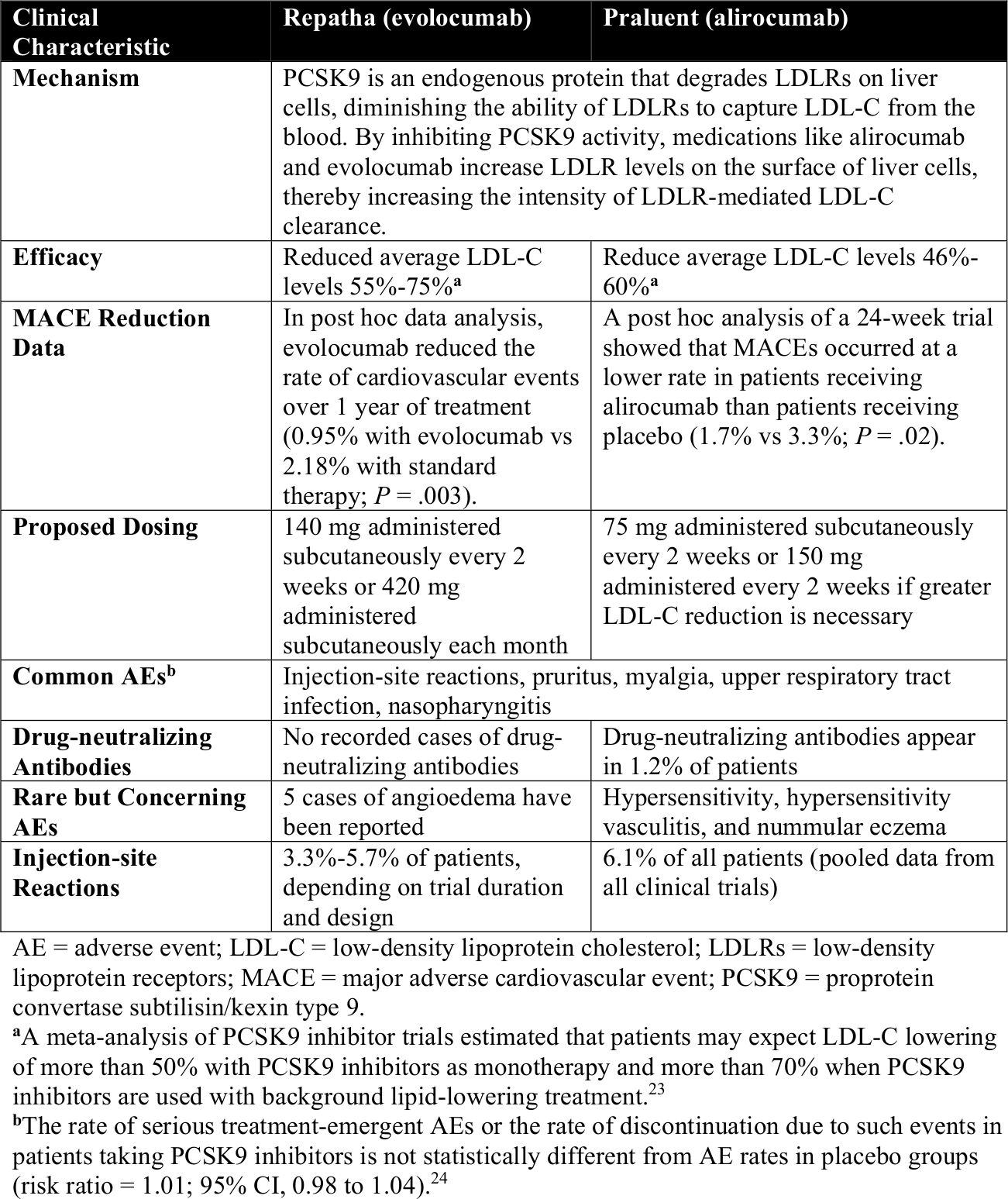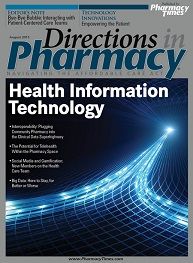Publication
Article
Pharmacy Practice in Focus: Oncology
PCSK9 Inhibitors: Their Likely Place in Hypercholesterolemia Therapy
Author(s):
PCSK9 inhibitors are a promising new class of drugs for patients with dyslipidemia, but where do they fit in therapy?
PCSK9 inhibitors are a promising new class of drugs for patients with dyslipidemia, but where do they fit in therapy?
In early June, FDA expert panels considered 2 new monoclonal antibodies of the treatment of hypercholesterolemia: Amgen’s Repatha (evolocumab) and Sanofi and Regeneron Pharmaceuticals' Praluent (alirocumab).1-5 (See Table.) Although these medications have not yet been approved, the FDA issued a favorable opinion of both drugs and insurers are concerned about their potentially high costs.6
Table: Evolocumab and Alirocumab Details1,2,21-24

According to Express Scripts Chief Marketing Officer Steve Miller, the effects of these medications on formularies could be enormous. At a recent conference, Miller stated, “Think about a lifetime drug that's probably going to cost greater than $10,000 annually times 71 million people.” CVS Caremark President Jon Roberts noted, “We think they’re going to be highly prescribed and they’re going to be very expensive.”6
Proposed indication statements for alirocumab and evolocumab from FDA briefing documents indicate that both drugs will likely have broadly defined indications for lowering “bad” low-density lipoprotein cholesterol (LDL-C) and raising “good” high-density lipoprotein cholesterol. In addition, both drugs are likely to receive indications for treatment of patients who are statin-intolerant, as well as patients with familial hypercholesterolemia (FH).1,2 With sweeping indications like these, millions of patients could be candidates for proprotein convertase subtilisin/kexin type 9 (PCSK9)-inhibitor therapy. Nearly 60 million US adults (or 1 in 4 individuals) have LDL-C levels that exceed 160 mg/dL.7 If half of these patients took PCSK9 inhibitors, spending on this class of medications would exceed $300 billion annually.
Fortunately, industry analysts do not expect this scenario to happen. Instead, financial analysts expect evolocumab and alirocumab to net a combined $6 billion in sales each year, with annual sales eventually reaching $10 billion for the entire PCSK9-inhibitor medication class.6 These expectations are consistent with much more conservative use of these medications.
Several factors, including the following, will limit the use of PCSK9 inhibitors to a narrow segment of patients with hyperlipidemia:
(1) True statin intolerance is very rare. In trials of PCSK9 inhibitors, investigators reported that up to 20% of patients with dyslipidemia are intolerant of statins, with most cases of intolerance resulting from muscle-related adverse events (AEs).8 Although it is true that more than 10% of patients taking statins experience mild myalgia, most of these cases are merely bothersome and are not dangerous.9,10
True rhabdomyolysis is marked by muscle injury, elevated levels of creatinine kinase, and organ damage. Fortunately, true rhabdomyolysis related to statin use is exceedingly uncommon.9,10 For instance:
- In a 450-patient retrospective analysis of veterans taking simvastatin 80 mg daily, 11.1% of patients reported myalgia, but only 1 patient (0.22%) developed true rhabdomyolysis.11
- Rhabdomyolysis rates from a study of nearly 500,000 patients taking lipid-lowering therapy show that 42 of 144 suspected cases met the clinical definition of this AE.9
- In another study of more than 1 million patients taking statins, fibrates, or both drugs together, there were only 70 cases of hospitalizations due to rhabdomyolysis.12
Rhabdomyolysis is not listed in briefing documents as a concern with PCSK9 inhibitors; yet, in a trial of evolocumab in patients who were statin-intolerant, 12% of patients receiving evolocumab for 12 weeks reported muscle-related AEs.8 A similar trial with alirocumab is in progress.13 The fact that patients who are statin-intolerant continue to report these AEs with a drug that has not been shown to cause rhabdomyolysis suggests that many of these patients, if not most, could have safely continued to receive oral statin therapy.
(2) Patients with FH have other options. In addition to high-intensity statin therapy, patients with FH have the option of using oral lomitapide, injectable mipomersen, and lipid apheresis. PCSK9 inhibitors will be 1 of several options.1,2
In some cases, using PCSK9 inhibitors with lipid apheresis may constitute duplication of therapy. On its own, lipid apheresis sessions reduce levels of circulating PCSK9 more than 50%.14 In addition, although PCSK9 inhibitors help optimize LDL-C reduction in patients with genetic forms of hyperlipidemia, they do not address the underlying genetic defect in FH in most cases.15
More than 80% of patients with FH have mutated LDL receptors that render the receptors less active in clearing LDL-C from the blood. In these patients, inhibition of PCSK9 will merely upregulate levels of an LDL-C—clearing protein that is only partly functional.15 Consistent with this, in clinical trials, LDL-C reductions in patients with severe forms of FH averaged around 30%—lower than the LDL-C reductions observed in patients without FH.1,2
Ideal candidates for PCSK9 inhibitors are a vanishingly small group of FH patients. In France, a study of 1358 patients with FH identified just 10 patients with FH due to overactive PCSK9. Only in this very small segment of patients would PCSK9 inhibition actually address the underlying genetic mutation causing the condition.16
(3) Long-term efficacy and safety studies are not mature. Although post hoc analyses of data for both PCSK9 inhibitors show morbidity and mortality benefits, trials proving a prospectively defined morbidity and mortality end point are incomplete. Results of the FOURIER trial with evolocumab are expected in 2017, and ODYSSEY outcomes with alirocumab are expected in late 2017 or early 2018.17,18
Thousands of patients have received both alirocumab and evolocumab, and both drugs are well tolerated. Even so, there are some lingering concerns about safety. For instance, neurocognitive AEs have been recorded with both treatments, 5 cases of angioedema have occurred in patients taking evolocumab, and cases of hypersensitivity and eczema have occurred in patients taking alirocumab. In addition, with evolocumab, 0.1% of patients developed renal disease or proteinuria compared with no such cases in control groups. About 1 in 20 patients taking either drug can expect injection-site reactions.1,2
The Case for Reserving Therapy
Statins have been used for decades, have a well-known AE profile, and have robust data showing reductions in all-cause mortality. In addition, high-intensity statin therapy can lower initial LDL-C levels by 50% or more.19,20 Although PCSK9 inhibitors are an important therapeutic development, it is important to reserve both the risks and benefits of a new treatment option to patients with high cardiovascular risk who are most in need of advanced therapies.
Michael R. Page, PharmD, RPh, earned his PharmD from the Ernest Mario School of Pharmacy at Rutgers University. He has worked as a community pharmacist at CVS Pharmacy and is currently clinical editor in clinical and scientific affairs at Pharmacy Times.
References
- FDA Advisory Committee briefing document: Praluent (alirocumab). FDA website. www.fda.gov/downloads/AdvisoryCommittees/CommitteesMeetingMaterials/Drugs/EndocrinologicandMetabolicDrugsAdvisoryCommittee/UCM449867.pdf. Accessed June 2015.
- FDA briefing document: Endocrinologic and Metabolic Drugs Advisory Committee (EMDAC). FDA website. www.fda.gov/downloads/AdvisoryCommittees/CommitteesMeetingMaterials/Drugs/EndocrinologicandMetabolicDrugsAdvisoryCommittee/UCM450072.pdf. Accessed June 2015.
- FDA Advisory Committee recommends approval of Regeneron and Sanofi's Praluent (alirocumab) injection for patients with hypercholesterolemia [press release]. Tarrytown, NY: Regeneron; June 9, 2015. http://files.shareholder.com/downloads/REGN/291494936x0x834686/F63401CF-4E49-4B8B-9783-7187EAF25CC1/REGN_News_2015_6_9_General_Releases.pdf. Accessed June 2015.
- Amgen to discuss details of Repatha (evolocumab) biologics license application for the treatment of high cholesterol [press release]. Thousand Oaks, CA: Amgen; June 10, 2015. www.amgen.com/media/media_pr_detail.jsp?releaseID=2058073. Accessed June 2015.
- Cholesterol-fighting drug evolocumab also reduces cardiovascular events, study finds. American Journal of Managed Care website. www.ajmc.com/conferences/acc15/cholesterol-fighting-drug-evolocumab-also-reduces-cardiovascular-events-study-finds. Published March 16, 2015. Accessed June 2015.
- Staton T. Payers fret about the next drug doomsday: pricey PCSK9 cholesterol meds. FiercePharmaMarketing website. www.fiercepharmamarketing.com/story/payers-already-fretting-about-next-pharm-apocalypse-pricey-pcsk9-cholestero/2014-05-07. Published May 7, 2014. Accessed June 2015.
- Verma DR, Brinton EA. Management of hypercholesterolemia for prevention of atherosclerotic cardiovascular disease: focus on the potential role of recombinant anti-PCSK9 monoclonal antibodies. Rev Cardiovasc Med. 2014;15(2):86-101.
- Stroes E, Colquhoun D, Sullivan D, et al; GAUSS-2 Investigators. Anti-PCSK9 antibody effectively lowers cholesterol in patients with statin intolerance: the GAUSS-2 randomized, placebo-controlled phase 3 clinical trial of evolocumab. J Am Coll Cardiol. 2014;63(23):2541-2548. doi: 10.1016/j.jacc.2014.03.019.
- Cziraky MJ, Willey VJ, McKenney JM, et al. Risk of hospitalized rhabdomyolysis associated with lipid-lowering drugs in a real-world clinical setting. J Clin Lipidol. 2013;7(2):102-108. doi: 10.1016/j.jacl.2012.06.006.
- Feng Q. Approach to clinical and genetic characterization of statin-induced myopathy. Methods Mol Biol. 2014;1175:67-90. doi: 10.1007/978-1-4939-0956-8_5.
- Mergenhagen K, Ott M, Heckman K, Rubin LM, Kellick K. Low vitamin D as a risk factor for the development of myalgia in patients taking high-dose simvastatin: a retrospective review. Clin Ther. 2014;36(5):770-777. doi: 10.1016/j.clinthera.2014.02.023.
- Amend KL, Landon J, Thyagarajan V, Niemcryk S, McAfee A. Incidence of hospitalized rhabdomyolysis with statin and fibrate use in an insured US population. Ann Pharmacother. 2011;45(10):1230-1239. doi: 10.1345/aph.1Q110.
- Study of Alirocumab (REGN727/ SAR236553) in Patients With Primary Hypercholesterolemia and Moderate, High, or Very High Cardiovascular (CV) Risk, Who Are Intolerant to Statins (Odyssey Alternative). ClinicalTrials.gov website. https://clinicaltrials.gov/ct2/show/NCT01709513?term=NCT01709513&rank=1. Accessed June 2015.
- Julius U, Milton M, Stoellner D, et al. Effects of lipoprotein apheresis on PCSK9 levels. Atheroscler Suppl. 2015;18:180-186. doi: 10.1016/j.atherosclerosissup.2015.02.028.
- Sinan ÜY, Sansoy V. Familial hypercholesterolemia: epidemiology, genetics, diagnosis, and screening. Turk Kardiyol Dern Ars. 2014;42(suppl 2):1-9.
- Marduel M, Carrié A, Sassolas A, et al; French ADH Research Network. Molecular spectrum of autosomal dominant hypercholesterolemia in France. Hum Mutat. 2010;31(11):E1811-E1824. doi: 10.1002/humu.21348.
- Langslet G, Emery M, Wasserman SM. Evolocumab (AMG 145) for primary hypercholesterolemia. Expert Rev Cardiovasc Ther. 2015;13(5):477-488. doi: 10.1586/14779072.2015.1030395.
- Schwartz GG, Bessac L, Berdan LG, et al. Effect of alirocumab, a monoclonal antibody to PCSK9, on long-term cardiovascular outcomes following acute coronary syndromes: rationale and design of the ODYSSEY outcomes trial. Am Heart J. 2014;168(5):682-689. doi: 10.1016/j.ahj.2014.07.028.
- Page MR. The new lipid guidelines: an in-depth look. Pharmacy Times website. www.pharmacytimes.com/news/the-new-lipid-guidelines-an-in-depth-look. Published November 19, 2013. Accessed June 2015.
- Brugts JJ, Yetgin T, Hoeks SE, et al. The benefits of statins in people without established cardiovascular disease but with cardiovascular risk factors: meta-analysis of randomised controlled trials. BMJ. 2009;338:b2376. doi: 10.1136/bmj.b2376.
- Sabatine MS, Giugliano RP, Wiviott SD, et al; Open-Label Study of Long-Term Evaluation against LDL Cholesterol (OSLER) Investigators. Efficacy and safety of evolocumab in reducing lipids and cardiovascular events. N Engl J Med. 2015;372(16):1500-1509. doi: 10.1056/NEJMoa1500858.
- Robinson JG, Farnier M, Krempf M, et al; ODYSSEY Long Term Investigators. Efficacy and safety of alirocumab in reducing lipids and cardiovascular events. N Engl J Med. 2015;372(16):1489-1499. doi: 10.1056/NEJMoa1501031.
- Ferdinand KC, Nasser SA. PCSK9 inhibition: discovery, current evidence, and potential effects on LDL-C and Lp(a). Cardiovasc Drugs Ther. Published online June 12, 2015.
- Li C, Lin L, Zhang W, et al. Efficiency and safety of proprotein convertase subtilisin/kexin 9 monoclonal antibody on hypercholesterolemia: a meta-analysis of 20 randomized controlled trials. J Am Heart Assoc. 2015;4(6):e001937. doi: 10.1161/JAHA.115.001937.







